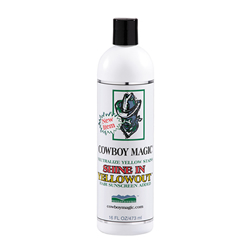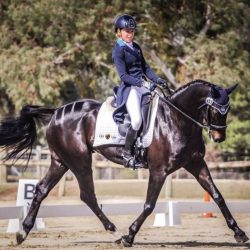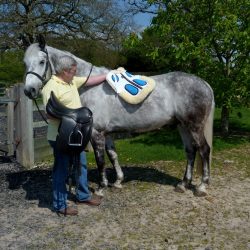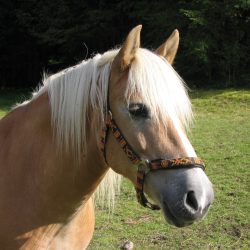 Being ‘on the bit’ and in a lovely outline is pleasing to look at, and a sign of a harmonious relationship between horse and rider – but it doesn’t start with the bit.
Being ‘on the bit’ and in a lovely outline is pleasing to look at, and a sign of a harmonious relationship between horse and rider – but it doesn’t start with the bit.
Having your horse between your leg and your hand is one of the main aims of flatwork and dressage, and is something we are constantly training for, and strive to achieve.
Once between leg and hand, your horse will be working properly, which should then make asking for lateral work and collection a little bit easier.
So what does ‘between leg and hand’ actually mean?
Well, first of all the leg part means they are in front of your leg, powering from behind, and creating energy from the hind quarters.
Then the rider’s hand is what softly contains and directs this energy, and keeps it underneath the rider; and getting the balance right is the key part.
 If you are too strong in your leg and too quiet in your hand, you’ll find the energy and impulsion that you’re creating just goes straight out of the front door. Likewise, too quiet off the leg, or too much hand, and you’ll have no energy to direct, or you may ‘block’ what forward momentum you do have.
If you are too strong in your leg and too quiet in your hand, you’ll find the energy and impulsion that you’re creating just goes straight out of the front door. Likewise, too quiet off the leg, or too much hand, and you’ll have no energy to direct, or you may ‘block’ what forward momentum you do have.
And if you don’t have the horse either in front of the leg, or pushing into a contact, it’ll make for a very under-powered and unexciting ride! So basically, when your horse is correctly working between your leg and hand, you’ll have the engine right underneath you, since they’ll be powering from the back end, and being contained from the front end. From here, you will be able to create dynamic work, work your horse into a soft contact (with the right bit for the horse’s mouth conformation and discipline), and be able to work towards collection.
So how do we teach our young horses or ‘green’ to be between our leg and hand? Being able to create impulsion and work towards collection is really quite advanced for the young horse, not only physically but mentally too, so the best we can hope for initially is just to have them in front of the leg into a safe and consistent contact. They must always learn to go forwards and off the leg first before you start trying to contain the energy, because they won’t have the strength or the discipline to be able to channel that energy from your hand aid’ and you’ll just end up restricting what forward energy you have created.
And it is so easy to rush a young horse’s education to the contact, just because you want them to look pretty, and go in an outline and ‘on the bit’ from the word go.
As riders we have to be very self disciplined, and not care what it looks like for the time being (with a youngster); the most important thing is going forwards and finding their natural rhythm.
After all, Rhythm and Suppleness come before Contact in the ‘Scales of Training‘! Once the horse have the idea of ‘forwards’, you will find it much easier to channel them into an elastic contact anyway, and you’ll be much closer to having them between your leg and hand than if you tried to force an outline initially. From here on, transitions and half halts will start the foundations of creating contained impulsion. It will take a long time and a lot of training, but by laying down the basic knowledge at the start, you’ll make less work for the future.

Bombers DC Dressage Bomber Blue bit
Naturally, you will want to choose a bit that optimises the harmony you’ve create and reduces mouth pressures where possible. We love the Bombers DC Dressage Swivel, which has swivelling elements designed to release as many pressure points within the equine’s mouth as possible, creating a comfortable communication. The bits are ideal for all disciplines.
The Bombers DC bit reins attach to the large dee-ring on the mouthpiece of the Bombers DC Dressage Swivel, which swings open independently of the bit’s cheekpieces. Further key features are the swivel mouthpiece, and the small, loose ring bridle attachment onto which the bridle’s cheekpiece affixes, which can rotate. This ensures the horse’s poll and cheek areas are relieved from rein engagement.
BD has approved the DC Dressage Happy Tongue Swivel (pictured below), a sweet iron mouthpiece which is curved and ported for tongue relief, and the DC Dressage Bomber-Blue Swivel (pictured above), made from a rubber-nylon compound, and also ported.
The swivel allows the mouthpiece to naturally adjust with the horse’s movements, maintaining a comfortable position. BD has ONLY approved the plain ‘dressage’ style of cheekpiece (the alternative version, known as the DC Morgan, has extra rein loops, and is not dressage legal).
The DC range is available from leading equestrian retailers as the Bombers DC Dressage Happy Tongue Swivel, and the Bombers DC Dressage Bomber-Blue Swivel. We believe the DC swivel is the ultimate range for reducing equine mouth pressure!
For UK stockist enquiries call us, distributor Equine Management, on 01825 840002. Watch Bomber Nel’s explanatory video HERE.
#bombersbits / #bombersbluebits / #teambombers #bombersbitsbringbalance
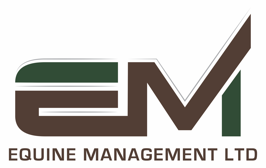
 MADE IN THE UK
MADE IN THE UK
